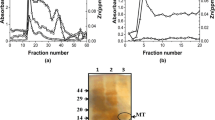Abstract
The effects of zinc (Zn) deficiency and repeated exposure to cadmium (Cd) on the accumulation and distribution of metallothionein (MT), Cd and Zn in the liver and kidney were studied. Male Sprague-Dawley rats were fed either a Zn-deficient (1 ppm) or a Zn-adequate (40 ppm) diet during the experiment, and the rats were injected subcutaneously with a cadmium chloride solution (1.0 mg Cd/kg of body weight, 5 days a week) for 4 weeks. Cadmium, Zn, and Cd-induced MT concentrations in the liver and kidney were lower in the Zn-deficient rats (−Zn + Cd) than in the Zn-adequate rats (+ Zn + Cd), while the content of Cd bound to high molecular weight proteins (HMWP) was greater in the Zn-deficient rats (−Zn + Cd). The Zn bound to Cd-induced MT was reduced to 30% in the liver and to 60% in the kidney of the Zn-deficient rats (−Zn + Cd) as compared with that of the Zn-adequate rats (+ Zn + Cd). In the kidney of Zn-deficient rats, exposure to Cd caused a decrease in essential Zn associated with HMWP as compared with that of Zn-adequate rats (+ Zn + Cd). Thus, Zn-deficiency affected the distribution of Cd in tissues, MT and HMWP and accelerated substantially Cd-induced Zn-deficiency in the kidney. Although the renal Cd concentration was lower in the Zn-deficient rats (−Zn + Cd) than in the Zn-adequate rats (+ Zn + Cd), exposure to Cd for four weeks resulted in glucosuria and an increase in liver and kidney weights in the Zn-deficient rats (−Zn + Cd), but not in the Zn-adequate rats (+ Zn + Cd). These results suggest that development of Cd toxicity is related to the Zn status of the body, to the accumulation of Cd in HMWP and to the amount of essential Zn associated with HMWP.
Similar content being viewed by others
References
Axelsson B, Piscator M (1966) Renal damage after prolonged exposure to cadmium: Experimental study. Arch Environ Health 12:360–373
Bremner I (1982) The effects of nutritional factors on the development of metal-induced renal damage. In:Bach PH, Bonner FW, Bridges JN, Luck EA (eds) Nephrotoxicity. Wiley, New York, pp 280–295
Bremner I, Davies NT (1976) Studies on the appearance of hepatic copper-binding protein in normal and zinc-deficient rats. Br J Nutr 36:101–112
Cain K, Holt DE (1983) Studies of cadmium-thionein induced nephropathy:Time-course of cadmium uptake and degradation. Chem Biol Interact 43:223–237
Friberg L, Piscator M, Nordberg G (1974) Cadmium in the environment. CRC press, Cleveland, OH
Goering PL, Klaassen CD (1984) Zinc-induced tolerance to cadmium hepatotoxicity. Toxicol Appl Pharmacol 74:299–307
Gunn SA, Gould TC, Anderson WAD (1968) Specificity in protection against lethality and testicular toxicity from cadmium. Proc Soc Exp Biol Med 128:591–595
Held DS, Hoekstra WG (1984) The effects of zinc deficiency on turnover of cadmium-metallothionein in rat liver. J Nutr 114: 2274–2282
Kägi JHR, Vallee BL (1961) Metallothionein: A cadmium and zinc-containing protein from equine renal cortex. II. Physicochemical properties. J Biol Chem 236:2435–2442
Mehra RK, Bremner, I (1983) Development of a radioimmunoassay for rat liver metallothionein-I and its application to the analysis of rat plasma and kidney. Biochem J 213:459–465
Nordberg M, Kojima Y (1979) Metallothionein and other low molecular weight metal-binding proteins. In:Kägi JHR, Nordberg M (eds) Metallothionein, Birkhäuser Verlag, pp 41–116
Onosaka S, Tanaka K, Cherian MG (1984) Effects of cadmium and zinc on tissue levels of metallothionein. Environ Health Perspect 54:67–72
Parizek J, Zabor Z (1956) Effects of cadmium salt on testicular tissue. Nature 177:1036–1037
Petering HG, Choudhury H, Stemmer K (1979) Some effects of oral ingestion of cadmium on zinc, copper and iron metabolism. Environ Health Perspect 28:97–106
Petering DH, Loftsgaarden J, Schneider J, Fowler B (1984) Metabolism of cadmium, zinc and copper in the rat kidney:The role of metallothionein and other binding sites. Environ Health Perspect 54:73–82
Sato M, Nagai Y (1980a) Mode of existence of cadmium in rat liver and kidney after prolonged subcutaneous administration. Toxicol Appl Pharmacol 54:90–99
— (1980b) Subcellular distribution of cadmium in rat liver on repeated cadmium administration. Eisei Kagaku 26:28–33 (in Japanese with English abstract).
-Sato M, Nagai Y (1982) Renal damage and form of cadmium in subcellular fractions. In: E.C. Foulkes (ed) Biological roles of metallothionein. Elsevier North Holland, pp 163–179
Sato M, Nagai Y, Nagasawa S (1983) Dysfunction in renal acidification process by cadmium administration in the rat. J Toxicol Sci 8:37–45
Shapiro SG, Squibb KS, Markowitz LA, Cousins RJ (1978) Cell-free synthesis of metallothionein directed by rat liver polyadenylated messenger ribonucleic acid. Biochem J 175:833–840
Suzuki KT, Yamamura M (1980) Isolation and characterization of metallothionein dimer. Biochem Pharmacol 29:689–692
Suzuki KT, Yamamura M, Yamada YK, Shimizu F (1980) Decreased copper content in rat kidney metallothionein and its relation to acute cadmium nephropathy. Toxicol Lett 7:137–142
Templeton DM, Cherian MG (1984) Effects of zinc deficiency on preexisting cadmium-metallothionein in the pancreas. Toxicology 29:251–260
Terhune MW, Sandstead HH (1972) Decreased RNA polymerase activity in mammalian zinc deficiency. Science 177:68–69
Wada O, Miyahara A, Manabe S, Matsui H, Ono T (1982) Effect of acute administration of cadmium on distribution of zinc in the hamster. J Toxicol Environ Health 9:509–513
Williams RB, Mills CF (1970) The experimental production of zinc deficiency in the rat. Brit J Nutr 24:989–1003
Winge DR, Premakumar R, Rajagopalan KV (1978) Studies on the zinc content of Cd-induced thionein. Arch Biochem Biophys 188:466–475
Yoshikawa H, Ohta H (1982) Interaction of metals and metallothionein. In:E.C. Foulkes (ed) Biological roles of metallothionein. Elsevier North Holland, pp 11–23
Author information
Authors and Affiliations
Rights and permissions
About this article
Cite this article
Sato, M., Nagai, Y. Effect of zinc deficiency on the accumulation of metallothionein and cadmium in the rat liver and kidney. Arch. Environ. Contam. Toxicol. 18, 587–593 (1989). https://doi.org/10.1007/BF01055026
Received:
Revised:
Issue Date:
DOI: https://doi.org/10.1007/BF01055026




